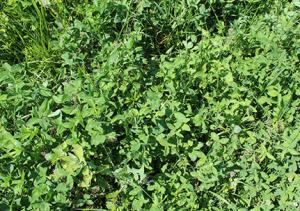John Carey is a busy man. He has a day job but in his spare time he has transformed 300 eroded acres of degraded land into a profitable grazing operation. How'd he do it? A vision. Good partners. A lot of hard work. And EQIP.
Transformation Man
- John & Dave Carey
- Girard, Illinois
- Acres: 300 acres in Macoupin County
- Crops: Corn, soybeans, oats, pasture
- Planting: All No-till
- Covers: Hay, barley, bromes, clovers, radish, triticale, festulolium, and alfalfa
Eight years ago, Carey bought degraded, eroded acres in Macoupin County. It was hilly ground , thick in hedges, thorns and shrubs. For two years, John and son Dave grew crops on the few acres they could and fed the small herd on corn and purchased forage and hay. All the while he envisioned a lush, grass-fed operation on these sad acres.
His soils were in bad shape. Most of the good soil washed away years ago and was probably resting somewhere in the Mississippi River. He hooked up with USDA’s Natural Resources Conservation Service, NRCS. He knew NRCS would offer ideas, plans, and technical assistance so he could do it right. On the job was NRCS’ Soil Conservation Technician Brad Burnet. He and Carey teamed up and walked the farm. Several times.
“We took a detailed inventory of the land, noting special problem areas, thinking of solutions and different structures we’d need. We needed to rebuild and restore the farm. And we had to manage water flow on the rolling landscape,’ Burnet explained.
Working together, they used NRCS' Environmental Quality Incentives Program (EQIP) to do it. EQIP offers practices to correct problems and financial help to pay for materials. The labor and earth moving, Carey did himself. “It’s a work in progress. But in five years, we’ve done a lot on these acres. Carey’s approach is to truly repair and rebuild the soil here. He’s doing that—he’s transforming these hills,” Burnet said.
They say it takes 500 years to build one inch of soil. Well, maybe it doesn’t take quite that long when you're rebuilding it. Carey and Dave used three EQIP contracts—two for David and one for John—to install several conservation practices for slope, water, soil health, and pasture establishment. EQIP does it all!

All their EQIP solutions manage and control water and livestock. Carey primarily uses ONE practice to rebuild his soils. Just one. Cover crops. “I frost seeded clover on two pastures in February. Everyone thought I was crazy. But you should see that clover…”
Carey has grown just about everything on his hills and future pastures to build soil health and improve the life, microorganisms, and organic matter. He’s grown hay, barley, bromes, clovers, radish, triticale, alfalfa—anything that keeps a living root in the soil every day. The soil is improving and producing. His forage pastures and cover crops do well.
In the beginning, Carey’s land could barely support 25 cows. As his soil improves, he’s expanded his herd to 45. For now.
Early on, Carey invested in a German-made wet baler and wrapper. It wraps and seals wet silage onsite, saving time and fuel and it secures the nutritional value of the feed. “My neighbors think I’m nuts. They are so resistant to change. That’s the biggest thing that holds people back is not changing. But you’re crazy not to change,” Carey explains.
Carey currently has five paddocks and will soon add new fencing, new pastures, and more paddocks as part of his Grazing Management Plan. At the start, he conducted soil tests to see where things were. Those results confirmed his soils were badly eroded. This summer new tests will show where things are at so he can adjust his strategy.
“As my soil and paddocks come together, I spend more time managing the whole operation, thinking and planning,” Carey said. Grazing and pasture management isn’t like row crop farming. It isn’t easy. It’s challenging and constantly changing. That’s what he loves about it.
For years, Carey experimented with different scenarios. Burnett offers advice on seeding mixes and combinations to try—be it for cover crops or forage. “He’s always willing to try something new on 10 acres or on a whole paddock just to see what happens. He sees how his cows like it and what it does for the soil. He likes to learn,” said Burnet.

Both are pleased with the land’s changing condition. “If you’d seen what he started with it and compared it to the thick clover and alfalfa fields we’re walking through today, it’s amazing. At one point, these hills couldn’t even grow Buckthorn. Now he’s getting multiple cuttings. He’s gonna need more cows!” Burnet adds.
According to Carey, he could not have made the transformation without NRCS and EQIP. “It’s been a true partnership. The program is flexible and worked great for me. I’ve learned so much. It has been a great way to learn and change my thinking. EQIP helped offset my costs for the equipment and materials and we did all the labor. Not a bad deal,” Carey adds.
To learn more about NRCS and how EQIP can help you address livestock or resource concerns on your land, visit the Illinois NRCS homepage today.
To learn more about using cover crops on your operation or improving the health of your soil, visit the Illinois NRCS Soil Health webpage or stop by your local USDA Service Center.
I keep cutting and grazing and stockpiling what we don't use. At this point,
I have a surplus. We're selling high quality forage and alfalfa to others.

